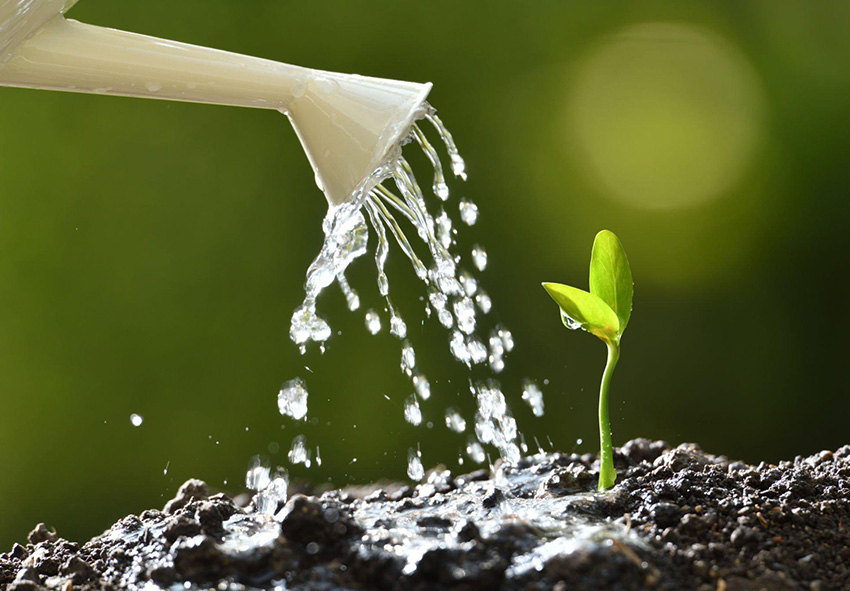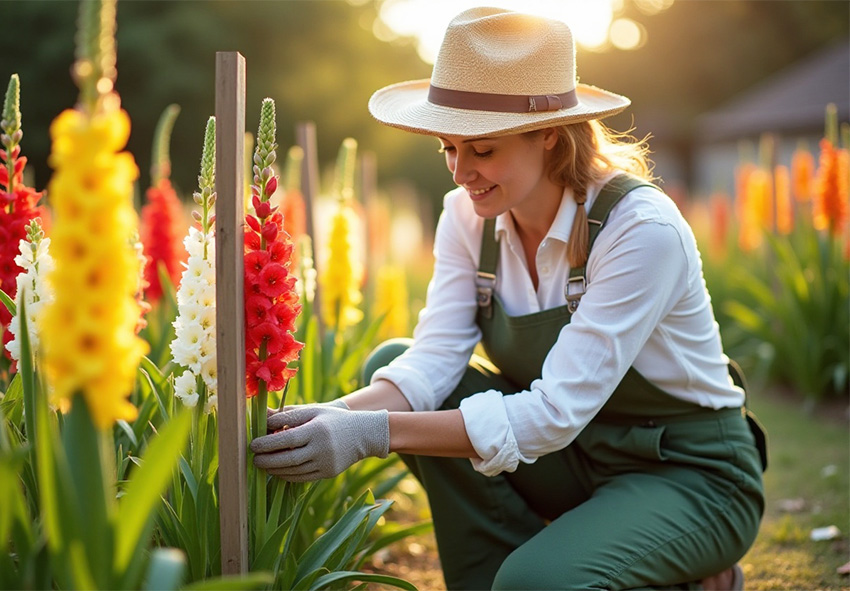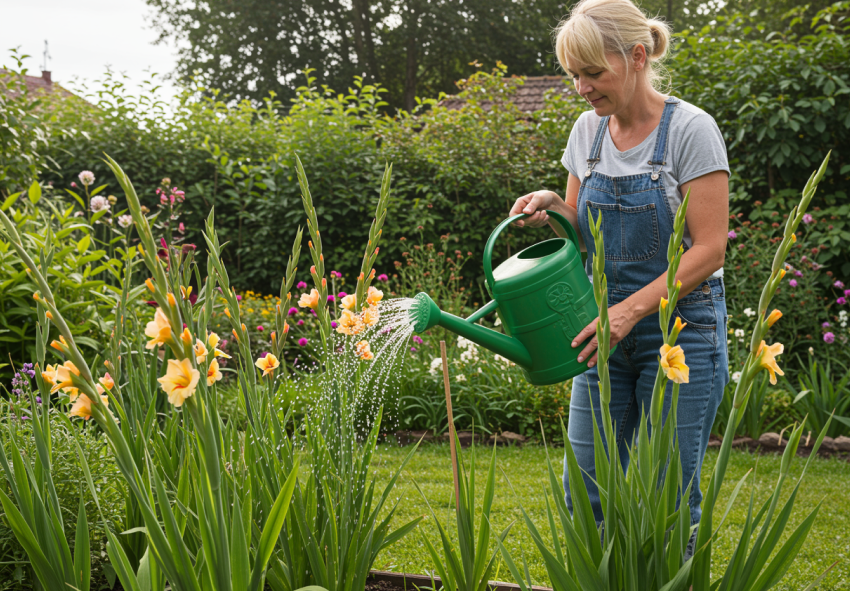Gladiolus, often called “sword lilies,” are prized for their tall, colorful spikes that brighten up summer gardens. While planting gladiolus corms is the first step, proper post-planting care is essential for vigorous growth and long-lasting blooms. This guide covers everything you need to know—from watering and fertilizing to staking and maintaining gladioli throughout the season. Our gardening blog is a perfect place to find all the information you need!
Immediate Care After Planting

Taking the right steps immediately after planting sets the stage for healthy gladiolus plants. The soil, moisture, and temperature all play crucial roles in early development. Here’s how to support newly planted gladioli from day one.
First Watering and Soil Moisture
Water your gladiolus corms thoroughly after planting to help settle the soil around them. Keep the soil consistently moist but not waterlogged during the first few weeks. A good rule of thumb is to water when the top inch of soil feels dry, which encourages root development without risking rot.
Mulching and Temperature Regulation
Apply a layer of organic mulch, such as straw, shredded bark, or compost, around the planting area. Mulch helps retain soil moisture, regulate temperature, and suppress weed growth. In cooler regions, it can also protect young shoots from late spring chills.
Gladiolus Watering Tips
Watering is one of the most important aspects of gladiolus care. These summer-flowering bulbs need consistent moisture to produce tall, vibrant flower spikes. Let’s explore how to water them correctly.
How Often to Water Gladioli
Water gladiolus deeply once or twice a week, depending on rainfall and soil conditions. Sandy soils may require more frequent watering than loamy soils. Aim for deep watering at the base to reach the roots, and avoid getting the leaves wet to prevent disease.
Signs of Underwatering or Overwatering
If your gladiolus plants aren’t receiving enough moisture, they’ll show visible signs of stress. Catching these signs of underwatering early can help prevent bloom loss and permanent damage:
- Drooping or curling leaves – The leaves may look limp, dry, or curled inward due to insufficient water intake.
- Stunted growth or no flower spikes – Lack of water can halt development, leading to smaller plants or a complete absence of flowers.
Too much water can be just as harmful as too little. Watch for these symptoms of overwatering to avoid root damage and rot:
- Yellowing leaves and soft stems – Excess water often leads to yellow foliage and weak, mushy stems, especially near the base.
- Rotting corms or foul smell – If you notice a sour or musty smell when checking the soil, it could indicate rotting corms from waterlogged conditions.
Feeding and Fertilization

Feeding your gladiolus at the right time with the proper nutrients ensures strong stems and large blooms. A balanced fertilization plan helps boost performance from early growth to peak flowering.
Best Fertilizers for Gladiolus
Use a balanced fertilizer like 10-10-10 or a slightly higher phosphorus ratio such as 5-10-10 to promote strong blooms. Apply the first dose when the shoots are a few inches tall, and again every 3–4 weeks during the growing season. Avoid high-nitrogen blends, which may lead to floppy foliage.
How to Apply Fertilizer Safely
Fertilizing gladiolus correctly helps them thrive, but improper application can harm the plants or soil. Using the right technique and timing ensures nutrients are absorbed efficiently without causing burn or imbalance. Follow these safe application methods to keep your gladioli healthy and blooming:
- Use diluted liquid fertilizer or evenly spread granular types: Always follow the recommended dosage on the label. For liquid fertilizer, dilute to half strength during early growth stages. If using granular fertilizer, scatter it around—not directly on—the base of the plant to avoid root burn.
- Water the soil before and after fertilizing: Moist soil helps absorb nutrients more effectively and prevents fertilizer from sitting on dry roots, which can cause damage. After applying fertilizer, water lightly to help carry nutrients into the root zone.
- Avoid contact with leaves and stems: Fertilizer should always be applied to the soil, not the foliage. Contact with leaves or stems can lead to leaf burn or discoloration.
- Time applications correctly: Apply fertilizer once gladioli are 6 inches tall, then again when flower spikes begin forming. Avoid late-season feeding, as it can promote weak growth susceptible to disease.
Supporting Gladiolus Stalks
Tall gladiolus spikes can become top-heavy, especially in windy or rainy weather. Staking is essential for keeping blooms upright and visually striking.
When and How to Stake Gladioli
It’s worth noting that growing large flowering gladioli requires some specific care tips. Stake gladiolus plants once they reach 12–18 inches tall, before they become top-heavy. Use bamboo stakes or garden canes, securing the stems loosely with soft ties. Space the stakes well to allow air circulation and reduce fungal risk.
Preventing Wind or Rain Damage
In windy locations, plant gladioli near a fence, wall, or among dense perennials that act as natural windbreaks. You can also plant in rows with the wind direction in mind to prevent toppling. Sturdy staking and protected placement help reduce storm-related breakage.
Long-Term Gladiolus Maintenance

Beyond the bloom period, gladiolus plants benefit from ongoing care that extends their beauty and ensures next season’s success. Deadheading and proper storage are crucial.
Deadheading Spent Blooms
Remove spent blooms promptly by cutting just below the faded flower. This not only improves the plant’s appearance but also encourages additional flower spikes. Deadheading redirects the plant’s energy into corm development rather than seed production.
Post-Bloom Care and Corm Lifting
Once your gladioli have finished blooming, proper end-of-season care is essential to ensure strong blooms in the following year. By managing the fading foliage and lifting corms correctly, you protect the bulbs from disease and cold damage. Here are the key steps to follow:
- Allow foliage to yellow before cutting back: After flowering, let the green leaves remain until they naturally yellow. This allows the plant to store energy back into the corm for next season’s growth. Only cut back the foliage when it’s dry and dead.
- Lift corms carefully before the first frost: Using a garden fork, gently lift the corms from the soil once the leaves have fully died back—usually 6–8 weeks after blooming. Avoid damaging the corms, as cuts can lead to rot during storage.
- Clean, cure, and store the corms properly: Shake off excess soil and trim off old stems. Let the corms dry in a well-ventilated area for 2–3 weeks. Once cured, store them in a cool, dry, frost-free place in mesh bags or paper boxes until planting season returns.
Conclusion
Caring for gladioli after planting is just as important as planting itself. With the right watering, feeding, staking, and maintenance practices, you’ll enjoy tall, vibrant blooms that steal the spotlight all summer long. Ready to grow your best gladiolus yet? Explore premium corms, fertilizers, and garden tools now in our online plant store!
Frequently Asked Questions (FAQs) about Care for Gladioli
1. How soon should I water gladiolus bulbs after planting?
You should water gladiolus bulbs immediately after planting to help settle the soil and start root development. Ensure the soil stays evenly moist but not soggy. A light watering every few days is sufficient at first, increasing as the plant grows and the weather warms up.
2. Do gladioli need to be fertilized right after planting?
Fertilizing right after planting isn’t necessary, but you can apply a balanced, slow-release fertilizer once shoots appear. Use a 10-10-10 or 5-10-10 NPK ratio. Avoid over-fertilizing early on, as it can burn young roots and reduce flower production later in the season.
3. Can I order gladiolus bulbs and supplies from your online store?
Yes, you can! Our online store Dutch-bulbs.com offers a wide variety of gladiolus bulbs in many colors, along with gardening tools and fertilizers designed specifically for bulb care. Visit our Gladiolus section to explore seasonal offers and expert-recommended products for the best planting results.
4. When should I stake my gladiolus plants?
Staking is recommended once gladiolus shoots are about 12–18 inches tall. Use bamboo stakes or garden supports placed a few inches from the base. Tie the stalk loosely to avoid damage, and adjust ties as the plant grows to protect it from wind or heavy blooms.
5. What should I do with gladioli after they finish blooming?
After blooming, leave the foliage in place until it yellows naturally—this helps recharge the corm. Once foliage dies back, cut it off and carefully dig up the corms. Clean, cure, and store them in a cool, dry place to replant the following season.
Published: 11.07.2025
